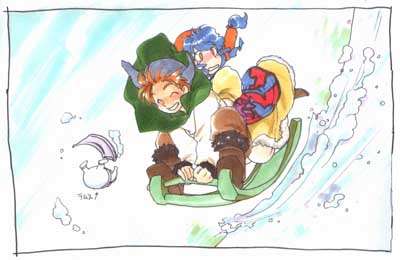

One of the bits salvaged on archive.org from one of the many old incarnations of Akari Funato's site, Himawari Lamp, found while I was searching for that UtR/VHM pic posted previously. That figure in the background is Ramus, by the way.
Coming out May 20, 2021.
OK, impressions, keeping in mind that I am not in the target audience for this promotion:
First, I just don't see Yue being the headlining love interest for this game. Julious, perfect angel man with the flowing golden mane, sure - he encapsulates the aesthetic for the classic franchise pretty well. Rayne, a vivacious, approachable redhead with what at the time was considered a cool aesthetic for a self-labeled Neo spin-off, absolutely. Yue's outfit looks like something Miles Edgeworth would eject from his wardrobe for being too, in his words, the entire circus. It's clearly meant to be commanding, but it has the exact opposite effect. And that fivehead! That fivehead! It undermines his characterization, too: Yue is consistently smug in his character portraits, but the huge head, as accentuated by the fivehead, infantilizes him (it's that phenomenon where children's heads are larger proportionate to the rest of their bodies than in adults; there's a developmental term for it I'm forgetting, but artists use it to infantilize characters, such as Zelda in Breath of the Wild). They mean Yue to be this enigmatic, take-charge figure, but he ends up looking like a smartass fourteen-year-old.
Second, the heroine looks supremely vacuous. It's a tradition in Angelique for the heroines to be actually pretty smart and capable in the games but airheaded in the manga and anime adaptations, but here, we seem to be going right to moths-in-the-brain - unless this is just an issue with Sayo Ichi's art, introducing the heroine with those big, vacant eyes and her mouth gaping. She doesn't seem to understand how key illustrations set the tone and expectations for a work and its characters.
I keep thinking that Angelique is going to grow beyond ribbons & twinkles & glissandoes, particularly when it's trying to reinvent itself for a new era, but it hardly ever does, not in its primary incarnations. I was thinking recently that in terms of aesthetic and tone, Angelique is the Japanese equivalent of Barbie. I understand that the current Barbie program is rather self-aware, though. Luminarise was the franchise's best bet for that, with the whole day-drunk, stressed-out businesswoman angle, but it looks like they pulled back on that somewhere in production. I wouldn't expect more if the series didn't produce some really strong characters who make for affecting stories when used well (A Scale of Infinite Notes; Farewell, Labyrinth; the Kuroki Tsubasa no Moto ni novel), but the writers rarely ever want to pull out the stops. And I don't know if Luminarise's characters are of that caliber.
I like what I see of the backdrops - the detail, the vivid color, the use of light. Felix is still one of the weakest designs to grace this series, though.
In true otome fashion, half the trailer is dedicated to an advertisement for the 15,000-yen deluxe version. I see from the promo materials, by the way, that the official translation for their little ActRaiser fortress is the "Floating City," not the "Flying City," as English fans have been using. I should change that in the Super Famicom translation. It's a mercy, frankly - I was torn between fumbling for a more elegant name or falling back on the somewhat-awkward "Flying City" convention.

A survey of the new Guardians, previewed from the bonus deluxe edition book. This is getting translated.
Incidentally, I put up a link to the Luminarise material here on my main site. I'm probably going to regret that. I liked being able to put down some thoughts in a relatively isolated space.
Page 43 of 56
